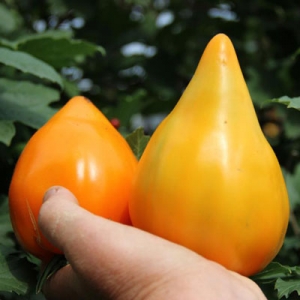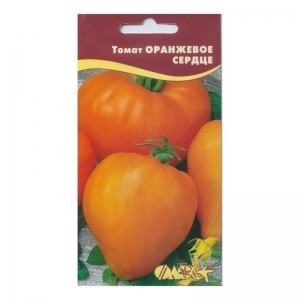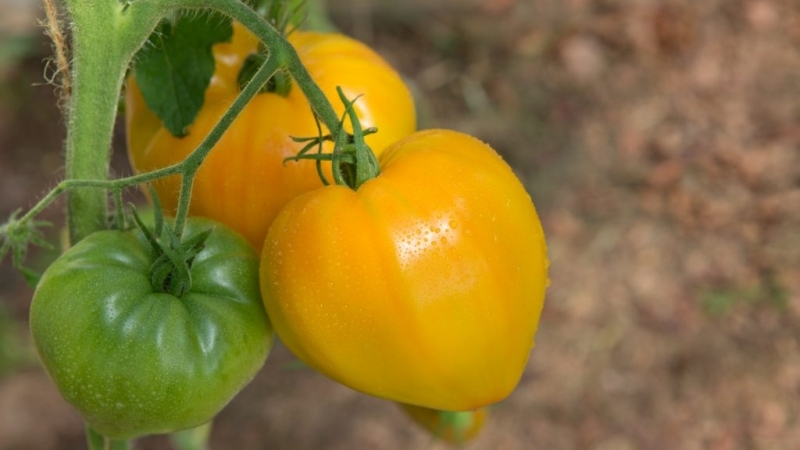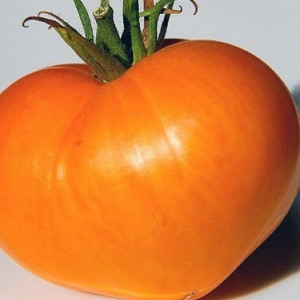The record holder for the content of nutrients is the Orange Heart tomato
Recently, scientists from the United States made a statement that yellow tomatoes are healthier than red and pink ones. These tomatoes are considered less allergenic. They contain not only increased amounts of vitamins, minerals and carotene, but also tetra-cis-lycopene. It is thanks to this compound that yellow tomato berries have the ability to prolong the youth of the body.
Among all varieties with yellow fruits, the Orange Heart tomato is especially popular. It has an interesting shape and produces large, sweet fruits that both adults and children eat with pleasure.
The content of the article
General description of the variety
Tomato Orange Heart is a variety bred by domestic breeders. It is included in the Russian state register and is popular with gardeners all over the world.
It is interesting! The variety was popularly called Liskin nose. This is due to the characteristic shape of its fruit, which resembles the muzzle of a ginger animal. This name quickly spread among gardeners, and now it is often found on foreign sites.
Distinguishing Features of the Orange Heart
 The main feature of the Orange Heart variety is the shape and color of the fruit. The berries of this tomato are heart-shaped with an elongated and pointed nose. The color of the tomatoes is orange or dark yellow.
The main feature of the Orange Heart variety is the shape and color of the fruit. The berries of this tomato are heart-shaped with an elongated and pointed nose. The color of the tomatoes is orange or dark yellow.
The taste of tomatoes is also impressive - sweet, with a pronounced fruity note and barely noticeable acidity. The berries are fleshy, moderately juicy. The composition contains a large amount of sugars.
Bushes are considered another feature. Despite the fact that the variety is indeterminate, gardeners note its spreading.
Note! Gardeners' reviews are burning that the fruits in the upper part of the bush are larger and have a sharper tip than in the lower part of the plant.
Main characteristics
Description of the variety Orange heart attracts many gardeners. After all, this tomato is not only useful and beautiful, but also undemanding to care for.
Features of Orange Heart Tomato:
| Parameter | Indicators |
| Bush type | Indeterminate... It reaches a height of 1.6-2 m. The stems are powerful and strong. Sprawling bushes with a lot of foliage. The leaves are dark green, medium-sized, simple tomato. The first inflorescence forms in the bosom of the 7th or 8th leaf. Subsequent brushes appear every 2 sheets. Fruits are formed in clusters with 3 to 6 berries on each cluster. |
| Growing method | Designed for cultivation in the climatic conditions of our country. It is cultivated in greenhouses, film shelters and open ground. |
| Yield | Average. Up to 4 kg of fruits are harvested from one bush during the fruiting period. From one square. m get an average of 8 kg of tomatoes. |
| Fruit | Large. The weight of one tomato varies from 250 to 400 g. The first fruits are always larger than the next. The fruits are bright orange or dark yellow on the outside. The pulp is orange, without light and green spots. The fruits are fleshy, not watery. Some gardeners note that they are not juicy enough. The shape of the berries is heart-shaped, with a strongly pointed tip. There is a pronounced ribbing at the base, which makes the tomatoes even more heart-like.There are many chambers in the fruits, but there are few seeds in them. |
| Transportability | Low. Due to their thin skin, tomatoes are not suitable for long-distance transport. Such tomatoes are not stored for long. They are prone to cracking. |
| Ripening terms | Mid-season variety. The first crop is harvested in 100-110 days. |
| Disease resistance | Resistant to most tomato diseases. Unstable to late blight. |
Growing seedlings
Tomatoes are cultivated in seedlings. Orange Heart seeds are sown in late February or early March. In the northern regions, seedlings begin to grow later - at the end of March.
Gardeners recommend that you familiarize yourself with the indicators of the lunar calendar to choose the optimal timing for growing seedlings. When growing seedlings in the Chinese way, you need to wait for the waning moon in the constellation Scorpio.
Preparation of planting material
The seeds must be prepared before use. This will reduce the likelihood of infection and speed up germination.
Store-bought planting material is usually already etched. This is evidenced by signs on the package and the green or orange color of the seeds.
If there are no signs indicating that the seeds are disinfected, or the planting material is taken from last year's harvest, the procedure must be carried out independently. To do this, the seeds are immersed for half an hour in a weak solution of potassium permanganate, and then washed.
To accelerate germination, seeds are treated with a growth stimulant: "Epin", a solution of honey, soda or aloe, "Fitosporin".
Selection of containers and soil
Often, tomato seeds are sown in one large, shallow container. Sprouted plants dive into pots with a volume of at least 300 ml.
Containers for seedlings are disinfected - soaked in a strong solution of potassium permanganate for half an hour or poured with boiling water.
Potting soil for tomatoes is sold in a specialty store. The soil is also prepared independently. For this, peat, chernozem and humus are mixed in equal amounts. Ash and sand are added to the composition.
The soil for seedlings is also disinfected - watered with boiling water, a solution of potassium permanganate or ignited in the oven.
Advice... To reduce the likelihood of damage to seedlings with a black leg, drainage is poured at the bottom of the picking pots. Broken brick, expanded clay or ceramics can play its role.
Sowing seeds
The planting material of the Orange Heart is buried 1-1.5 cm.A distance of at least 2 cm must be maintained between the seeds.
After sowing the seeds, the soil is moistened with warm water from a spray bottle. The seedlings are covered with foil and placed in a warm place. The warmer it is in the room, the faster the first shoots will appear. Light is not required for non-germinated seeds.
Seedling care
Taking proper care of your seedlings will help you grow healthy and strong plants. How to grow seedlings:
- Before the seeds germinate, the containers are covered with foil. This will provide high humidity and the necessary microclimate for their germination.
- After the first shoots appear, the container with the seedlings is placed in a well-lit place. To prevent the plants from stretching, gardeners recommend using fluorescent lamps.
- A week after germination of the seeds, the film is removed. Prior to this, the seedlings still need extreme moisture.
- For irrigation, use only settled water at room temperature. Water the tomatoes so that water does not get on the greens.
- Plants dive when the first true leaves appear on them. You do not need to pinch the root during the transplantation.
- The first time the plants are watered after picking in a week. A week later, the seedlings are fed.
- For the entire period of growing seedlings, it is fed three times. Complex fertilizers or biohumus are used. 3 days before planting in a permanent place, tomatoes are fed with fertilizers with potassium and phosphorus.
- Before planting in a permanent place, the tomatoes are hardened.For this, the plants begin to take out into the street two weeks before the pick, gradually increasing the time of their stay there.
Tomato Agricultural Technology Orange Heart
The orange heart is grown in open and protected ground. In cold regions, option 2 is preferable.
Tomatoes are planted when the soil warms up. The optimal picking time is March. In the southern regions, disembarkation is possible at the end of April, and in the northern regions - in early June.
Before picking, tomatoes need to be prepared. To do this, 3 days before the procedure, the plants are watered and fed.
Landing rules
Tomato beds are prepared in advance. In the fall, the soil is dug up and cleaned of weeds, after which it is enriched with mullein, ash and lime. In the spring, the soil is again dug up and watered with a solution of copper sulfate.
For tomatoes, dig holes in rows. For 1 sq. m place 2-3 plants. 1 tablespoon of ash is poured into each depression.
Seedlings are carefully removed from the pots. It is placed in the center wells. The depressions are filled with water and covered with soil. The next watering after planting seedlings is possible no earlier than 2 weeks later.
How to care for a tomato
Bushes varieties Orange heart need garter... The support is chosen strong and high. This can be a wooden peg or trellis.
The plant is formed into 2 or 3 stems. The more stems, the slower the harvest will ripen and the smaller the fruits will be.
Lower leaves and excess tomato shoots are regularly removed. This procedure is carried out in the morning or in the evening on clear days.
The soil is moistened as it dries. It is important to consider that in dry weather or high humidity, the fruits crack.
Fertilize tomatoes 3-4 times per season. Gardeners recommend alternating mineral complex fertilizers and manure. Foliar boron feeding help the ovaries to form faster.
Attention... Loosening of the beds is mandatory. This procedure breaks down the crust and improves air exchange in the roots. Loosening is carried out after each watering and rain.
Nuances of growing tomato Orange heart
Orange heart is an unpretentious variety. It is undemanding to feeding, and following the basic rules, even novice gardeners can successfully grow it.
 Most tomatoes require three to four feedings per season, but two are enough for Orange Heart. It is better to use complex fertilizers.
Most tomatoes require three to four feedings per season, but two are enough for Orange Heart. It is better to use complex fertilizers.
When pinching, it is important to remove the entire body of the appendix. If the stepson is not completely removed, the likelihood of infection of the plant will greatly increase.
Diseases and harmful insects
Tomato Orange Heart is immune to viral and fungal diseases. However, it is affected by late blight.
To avoid tomato disease, follow the rules of caring for them. Do not overmoisten or overdry the soil. Such conditions are ideal for the development of pathogens.
It is necessary to disinfect not only the soil and planting material. All gardening tools that will interact with tomatoes must go through the disinfection procedure. They can contain fungi and viruses.
For the prevention of late blight, plants are sprayed with preparations with copper. Another way is spraying with potassium permanganate solution.
It is important to protect plants from harmful insects. They not only spoil the bushes themselves, but also infect them with fungi and viruses.
Thrips, whitefly and spider mites are afraid of celandine infusion. Slugs are repelled by a solution of ammonia. To get rid of aphids, use a soapy solution. These means are sprayed on the ground parts of the plant.
Features of growing in protected and open ground
When growing Orange Heart tomatoes in the open field, it is important to protect the plants from frost for the first two weeks after transplanting. To do this, they are covered with foil overnight. The same technique is used on cool days.
Mulch beds of tomatoes grown in the open field are required.This will protect plants from frost, drying out of the soil, pests and parasites.
Greenhouses with tomatoes are ventilated daily by opening the vents in the room.
Harvesting and application of the crop

The first fruits of the Orange Heart ripen in July. The berries of the tomatoes turn bright orange and soft.
On cloudy days or during an epidemic, phytophthora pluck large unripe fruits. In this case, be sure to leave the stalk. Then the tomatoes will ripen quickly indoors.
Tomatoes Orange Heart are intended for fresh consumption. It is possible to prepare sauces and juices from fruits. In general, they are not preserved due to the fact that they crack and soften.
Advice... Gardeners recommend not throwing away the cake left over from the preparation of tomato juice. This raw material is used as fertilizer for tomato and other crops.
Advantages and disadvantages of the variety
Benefits of tomato:
- unpretentious care;
- sweet fruity taste;
- pronounced aroma;
- large-fruited;
- immunity to tomato diseases;
- beautiful shape and bright color.
The disadvantages include the low transportability of tomatoes and the need for pinching.
Farmers reviews
Reviews of the Orange Heart tomato are positive. Gardeners note the excellent characteristics of these tomatoes.
Ilya Sadovnik, Klin: «I was presented with Orange Heart tomato seeds last year. I grew them in a greenhouse. The stems are tall and powerful. The first fruits had a strongly pointed shape and resembled a heart. The following tomatoes were rounder. Closer to autumn, the plants got sick with late blight. "
Alina Kryukova, Sochi: "Liskin's nose (Orange heart) tomatoes have been growing for the second year. I like beautiful sweet fruits that are great for salads. I did not notice any special difficulties in growing. The largest tomato of this variety weighed 378 g. ”
Conclusion
Tomato variety Orange Heart is popular with both beginners and experienced gardeners. It produces healthy and tasty orange-colored heart-shaped fruits. Tomatoes are undemanding to care, they are cultivated even in summer cottages. Tomatoes look great in salads and other dishes and are suitable for whole-fruit canning.